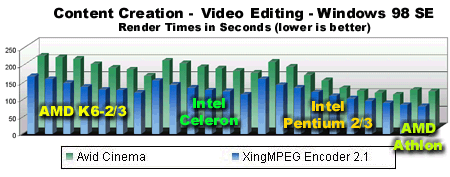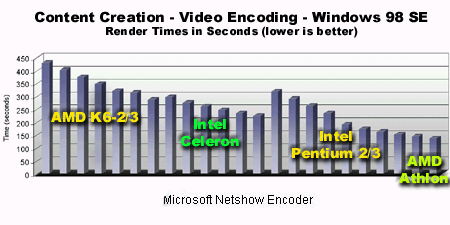Desktop CPU Comparison - September 99
by Anand Lal Shimpi on September 6, 1999 1:23 AM EST- Posted in
- CPUs

Here we have a very interesting test combination, the first benchmark, Avid Cinema, is an Intel supplied utility and the second, Xing MPEG Encoder, is part of the SYSmark 98 suite. The results? As you can expect, the Avid Cinema benchmark is highly optimized for SSE, making the Pentium III the fastest contender out of the bunch. Ignore the Pentium III's scores, and what do you see?
For one thing, the K6-2 is very competitive in this Intel benchmark, indicating a possible strength for the slowly dying Super7 platform, desktop video editing. Clock for clock, the K6-2 is on the heels of the Celeron, with the K6-III 450 scoring higher than the Celeron 500. Video editing generally prefers on having a fast hard disk and more memory rather than a faster CPU, which would bring us to the conclusion that if you're only looking to do some amateur editing, as long as you have the storage space and can transfer the data quickly enough, CPU performance isn't too incredibly important (not to say that you should try making a movie on a 486, but a faster CPU isn't going to give you the most bang for your buck in terms of video editing performance).
The Athlon still remains very competitive in spite of the benchmark's SSE optimizations, however this just goes to show you that using the right benchmarks, a company can claim anything, even if it isn't true in all cases.
The Xing MPEG Encoder benchmark, part of the SYSmark 98 suite, yields similar results with the K6-2 and K6-III not falling too far behind the competition at lower clock speeds and remaining quite competitive at higher ones. With this benchmark, there aren't any optimizations to help differentiate between the Pentium III and Athlon architectures, so the difference between the Pentium III 600 and the Athlon 600 is minimal. The larger L1 cache of the Athlon helps out a little bit in achieving greater performance than its Intel counterpart, but the 200MHz FSB helps it prove its strength albeit a small show of force on the Athlon's part.
The Xing benchmark also provides us with another example where the Celeron is slower than the Pentium II/III at an equivalent clock speed, however this time the difference is about 10%. It's up to you, as a consumer, to decide whether that 10% performance increase is really worth the added cost of the Pentium III over the Celeron. How much are you willing to pay for 10%?

The Microsoft Netshow Encoder benchmark is a part of the Intel Business Application test suite and fortunately turned out to be a very nice test for comparing CPU performance since there was very little Intel could do with the benchmark routine to make it heavily optimized for SSE, thus illustrating one of the limitations of SSE/3DNow! optimizations, they don't always benefit you as much as the manufacturers would like to make you think they can.
The Athlon comes away with the lead in this benchmark, but more importantly are the figures to the left of the graph. The K6-2 and even the K6-III lag behind the competition by a considerable amount, and even the Intel Celeron loses out to the Pentium II on a clock for clock basis. The Pentium III and Athlon come away in this benchmark as being the best performers with the most potential in this sort of an application.










0 Comments
View All Comments